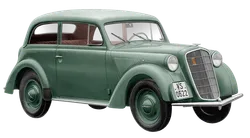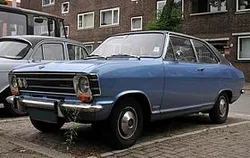

Opel Olympia - Opel Olympia A for Sale
Explore the Opel Olympia and Opel Olympia A, featuring specifications and choices. Discover unique models in Portugal that cater to car enthusiasts!
The Opel Olympia A was a German car model that was produced by Opel from 1935 to 1940. It was the first generation of the Opel Olympia series, and it quickly became popular due to it...
Technical Specifications
Select Version
Dimensions
Engine
Driving
Others
History and Features
Mycarro AI
Feb 1, 2024
Introduction
The Opel Olympia A was a German car model that was produced by Opel from 1935 to 1940. It was the first generation of the Opel Olympia series, and it quickly became popular due to its stylish design, innovative features, and affordable price. The Olympia A was a compact car that offered a comfortable ride and good fuel efficiency, making it an ideal choice for many car enthusiasts during the 1930s.
The Design
The Opel Olympia A featured a sleek and aerodynamic design, which was quite advanced for its time. The car had a rounded shape with smooth lines that gave it a futuristic appearance. It was available in various body styles, including a 2-door coupe, a 4-door sedan, and a convertible. The Olympia A also had distinctive chrome accents and an iconic Opel badge on the front grille, further adding to its overall appeal.
Performance
Under the hood, the Opel Olympia A was equipped with a 1.3-liter inline-four engine that produced around 24 horsepower. While this may not seem like much by today's standards, it was quite impressive at the time. The Olympia A had a top speed of about 68 miles per hour, which was considered fast for a compact car back then. The car featured a rear-wheel-drive layout and a manual transmission, providing a smooth and enjoyable driving experience.
Features and Innovations
One of the key features of the Opel Olympia A was its innovative suspension system. It had independent front suspension with a transverse leaf spring, which allowed for better handling and a comfortable ride. The Olympia A also had hydraulic brakes, which were a new technology at the time. These brakes provided excellent stopping power and increased safety for the driver and passengers.
Another notable feature of the Olympia A was its spacious interior. Despite being a compact car, it had a surprisingly roomy cabin that could comfortably seat four to five people. The upholstery and trim materials were of high quality, giving the interior a luxurious feel. Additionally, the car came with a range of optional accessories, including a radio and a heater, which were considered luxurious additions in the 1930s.
Legacy
The Opel Olympia A was highly successful during its production years and played a significant role in Opel's history. It was a symbol of German engineering excellence and craftsmanship. The Olympia A paved the way for future generations of the Opel Olympia series, which continued to be popular even after World War II. Today, the Opel Olympia A is highly sought after by classic car collectors and enthusiasts, and it is considered a valuable piece of automotive history.
Conclusion
The Opel Olympia A was a groundbreaking car model that left a lasting impact on the automotive industry. Its stylish design, innovative features, and affordable price made it a favorite among car enthusiasts during the 1930s. With its sleek appearance, impressive performance, and comfortable interior, the Olympia A truly stood out from its competitors. As a classic car from the past, it continues to be admired and cherished by car enthusiasts who appreciate its historical significance and timeless appeal.
